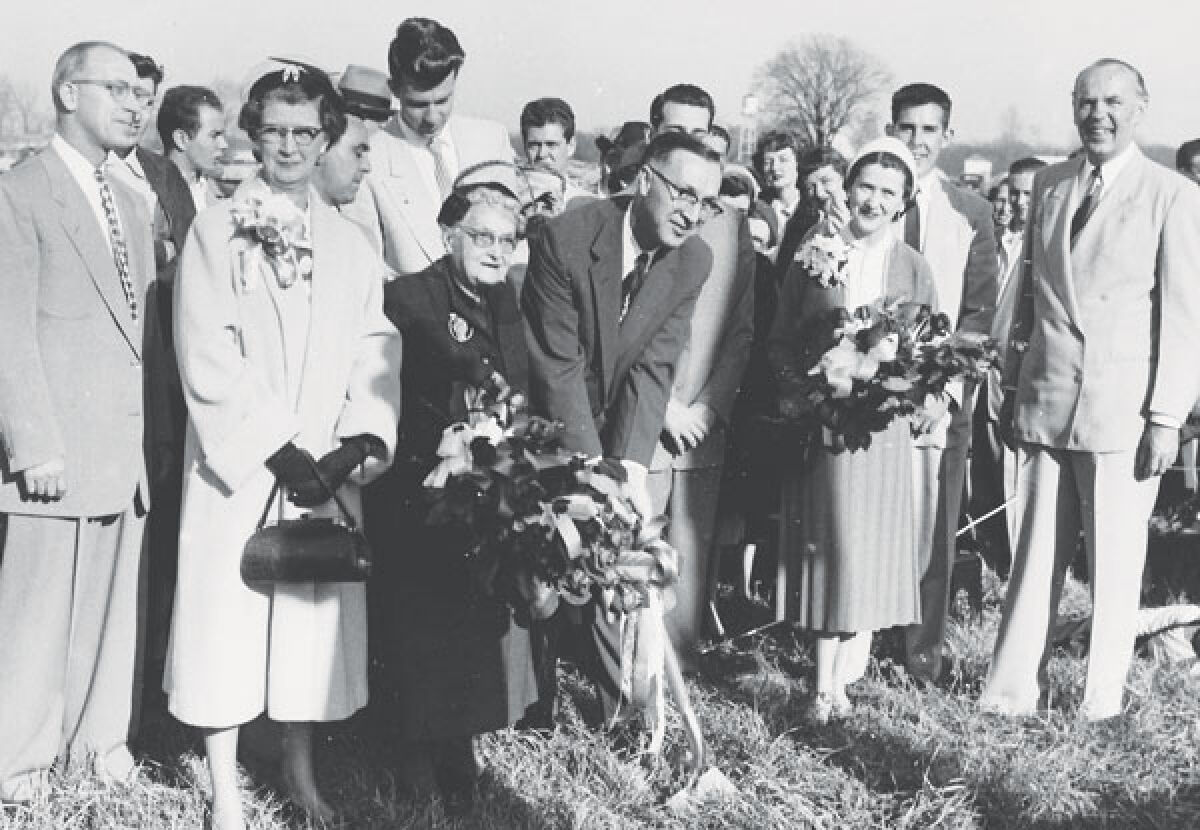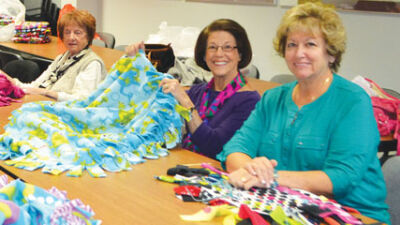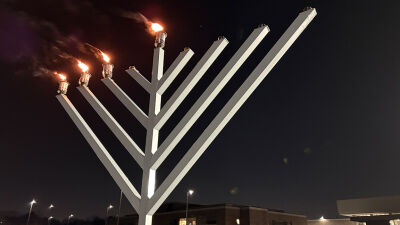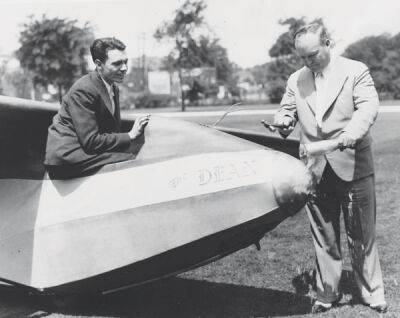
The founder of LTU, Russell Lawrence, is shown using a bottle of Prohibition-legal wine to christen a glider designed by student Jack Laister in the cockpit. The plane was named “The Dean” in Lawrence’s honor.
Photo provided by Bruce Annett
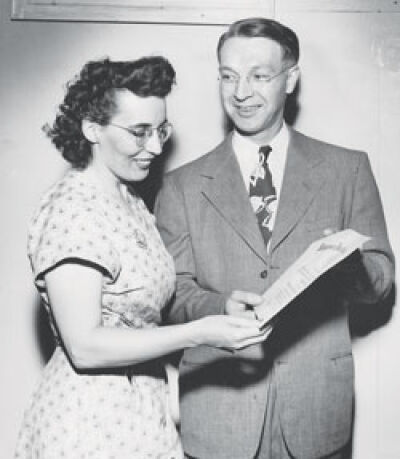
In 1949, Theresa Shepard Tierney was Lawrence Tech’s first female graduate. She is pictured with George Lawrence as she receives her degree.
Photo provided by Bruce Annett
SOUTHFIELD — After 46 years working in Lawrence Technological University’s communications and marketing department, Bruce Annett just can’t stay away from LTU.
Annett has been using his knowledge from his former role to draft the first-ever book on the history of LTU, “Tomorrow in the Making: A Lawrence Technological University History.”
Annett has watched history unfold before his very eyes, having worked under six of the eight presidents of the university.
Lawrence Tech celebrated its 90th anniversary last year, and now, nearing its centennial, it seemed about time that someone captured the longstanding innovation and dedication of the institution.
According to Lisa Kujawa, the vice president of enrollment management at LTU, Annett was the perfect person for the job.
“Bruce and I go way back, and I wouldn’t be as good at my job without him, because he knows so much of the history. I’ve been here 25 years, and when I think about when I came and all the things we wanted to accomplish then and now, I realize I’ve worked for four presidents. And I really believe they do stand on each other’s shoulders. So that vision that they were trying to achieve moving forward, they all work in conjunction with each other to move the university forward,” Kujawa said.
The story of Lawrence Tech begins with Russell Lawrence, one of the founders of the university. Russell was originally from Indiana and attended engineering college there. He moved to Michigan for a job at the University of Detroit Mercy in the 1920s. It was here that he would develop a reputation within the engineering field and become the dean of engineering at U of D. During that decade or so, Russell had grown the engineering program at U of D from around 30 to 1,200 students. Unfortunately, it all ended in 1932, when he was laid off due to the Great Depression.
However, according to Annett, Russell was determined and entrepreneurial. He believed that if America were going to come out of the depression, it would be due to the fields of engineering and technology. Annett explained that through Russell’s friendship with Henry and Edsel Ford, he was able to lease a building from them in Highland Park, which was next to the Model T factory. Annett stated that the factory was the “biggest, most prolific factory in the world at that time.” The building sat at the edge of the Ford factory and was originally built as an orphanage in 1908 before Henry Ford purchased it. Lawrence Tech was housed in that original location from 1932 until 1955, when they moved to their current location at 21000 W 10 Mile Road.
Unfortunately, Russell Lawrence would never see the university grow into the vision that he had for it. In 1934, two years after LTU was founded, he passed away from cancer. Kujuwa shared that while Russell was on his deathbed, he told his younger brother, George, that he had to pursue this vision of innovation now. Russell wrote on the back of a business card that George was now the president. Annett described George at the time as “young and inexperienced,” but having made that promise to his dying brother, he was determined to create the university that Russell envisioned.
As George assumed the role of president, he was faced with the challenge of picking up the momentum that his brother had left off. When World War II hit, George had to get innovative with how to keep the university afloat.
“We went from a couple of thousand students at the time down to 300 or 400 students. George Lawrence was afraid we would have to close,” Annett stated. “But we ended up not closing, because he was concerned that if we closed, it would be hard to get started again. So he didn’t. He kept going.”
It was during this time that LTU accelerated its academic programs. For example, what would have been a four-year engineering program became achievable in two and a half years by going nights, days and weekends. LTU also enrolled about 10,000 people from the area to work in specialized training to help with the war effort, such as specialty courses on how to be an efficient manufacturer, as well as sophisticated engineering and mathematics. It was also at this time when LTU began enrolling women.
Annett stated that women first enrolled at LTU in large numbers during World War II. Theresa Shepard Tierney, Bachelor of Science in electrical engineering ’49, was Lawrence Tech’s first female graduate. According to Annett, now, over 25% of LTU’s student population is female.
“It was a miracle, but Lawrence Tech survived World War II,” Annett said. He attributes this success to the shift that LTU underwent during the war.
“In Detroit, all of the industries here that built cars and trucks before the war switched over to creating weaponry and other resources to aid the war effort. Thus, the ‘Arsenal of Democracy’ name that Franklin Roosevelt called us. And so a lot of our students, faculty, staff and alumni were involved in that transition from a peacetime manufacturing economy to a wartime economy. And then back again, when the war was over, going back to consumer goods, like cars and trucks and washing machines.”
After the war, LTU’s numbers continued to grow, and George knew it was time for a new location. He purchased some acreage that would eventually become the Northland property but ended up selling it to persistent buyers before any developments were made. General Mills Research Farm had been in the area since the 1920s but went up for sale around the time George was looking for land. He purchased 107 acres from General Mills and transitioned the property from farmland to an academic institution of innovation and technology.
After facing a period of uncertainty during its first two decades due to external events, Lawrence Tech experienced significant growth and progress following the transition to a new campus. LTU found that having class offerings available from 8 a.m. until 11 p.m. was not only convenient for students balancing families and jobs, but also was an efficient way to use facilities to reduce costs and keep tuition on par with public universities in the area. In addition to the reputation LTU had built in the engineering and technology fields, the university became one of the largest colleges of architecture in the country based on its practical application approach to learning in the 1960s.
Through each decade, LTU has been conscious of its motto, “theory and practice.”
Almost 100 years later, Kujawa finds herself meditating daily on the original mission that the Lawrence brothers set out to accomplish and the legacy they’ve left behind. Kujawa keeps pictures of Russell and George Lawrence above her desk in her office as a reminder of what Lawrence Tech represents.
“I think the beauty of Lawrence Tech is what they call agility,” Annett stated. “They can move and create new programs or add new parts of programs. Here, if somebody wants to do something, it can happen pretty quickly. That spirit of innovation, that agility, really dates back to the school’s earliest days. Lawrence Tech is extremely close to the vision that Russell Lawrence had in 1932. His statement from 1932 that engineering and technology will get us out of the depression and change the world, we still adhere to.”
Annett’s book does not have a set release date, but it is expected to reach completion by the end of the year. For more updates from LTU, visit www.ltu.edu.
 Publication select ▼
Publication select ▼